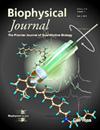Comparative Analysis of the Bending Modulus for Phosphatidylcholine, Phosphatidylethanolamine, and Sphingomyelin Membranes Based on Coarse-Grained Molecular Dynamics Simulations.
IF 3.2
3区 生物学
Q2 BIOPHYSICS
引用次数: 0
Abstract
Bilayer membranes are essential biological structures with complex and largely unexplored mechanical properties. Using coarse-grained molecular dynamics simulations, we evaluated the bending modulus across diverse lipid compositions, including phosphatidylcholine (PC), phosphatidylethanolamine (PE), and sphingomyelin (SM). Three computational techniques were employed to calculate the bending modulus from thermal fluctuations of the simulated bilayers: the Fourier transform of the lipid height function (q-4 fitting), Bedeaux-Weeks Density Correlation Functions (BW-DCF) method, and Real Space Fluctuations (RSF). The analysis revealed substantial variations in bending modulus values across methods, underscoring the inherent complexities and discrepancies in computational assessments. These findings advance our understanding of membrane dynamics and provide valuable insights into bilayer structural behavior. The results support the broader application of computational approaches to study biological systems and inspire the development of biomimetic materials with tailored mechanical properties.基于粗粒度分子动力学模拟的磷脂酰胆碱、磷脂酰乙醇胺和鞘磷脂膜弯曲模量的比较分析。
双层膜是一种重要的生物结构,具有复杂的力学特性。使用粗粒度的分子动力学模拟,我们评估了不同脂质组成的弯曲模量,包括磷脂酰胆碱(PC)、磷脂酰乙醇胺(PE)和鞘磷脂(SM)。利用脂质高度函数的傅里叶变换(q-4拟合)、bedeau - weeks密度相关函数(BW-DCF)方法和真实空间波动(RSF)三种计算技术计算模拟双层的热波动的弯曲模量。分析揭示了不同方法的弯曲模量值的巨大差异,强调了计算评估的固有复杂性和差异。这些发现促进了我们对膜动力学的理解,并为双层结构行为提供了有价值的见解。这些结果支持了计算方法在生物系统研究中的广泛应用,并激发了具有定制机械性能的仿生材料的开发。
本文章由计算机程序翻译,如有差异,请以英文原文为准。
求助全文
约1分钟内获得全文
求助全文
来源期刊

Biophysical journal
生物-生物物理
CiteScore
6.10
自引率
5.90%
发文量
3090
审稿时长
2 months
期刊介绍:
BJ publishes original articles, letters, and perspectives on important problems in modern biophysics. The papers should be written so as to be of interest to a broad community of biophysicists. BJ welcomes experimental studies that employ quantitative physical approaches for the study of biological systems, including or spanning scales from molecule to whole organism. Experimental studies of a purely descriptive or phenomenological nature, with no theoretical or mechanistic underpinning, are not appropriate for publication in BJ. Theoretical studies should offer new insights into the understanding ofexperimental results or suggest new experimentally testable hypotheses. Articles reporting significant methodological or technological advances, which have potential to open new areas of biophysical investigation, are also suitable for publication in BJ. Papers describing improvements in accuracy or speed of existing methods or extra detail within methods described previously are not suitable for BJ.
 求助内容:
求助内容: 应助结果提醒方式:
应助结果提醒方式:


